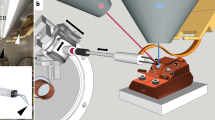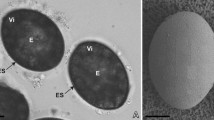Abstract
At the ultrastructural level, a trilaminate structure, designated as the epicuticle, is always present on the outermost surface of the nematodeCaenorhabditis elegans. The freeze-fracture technique revealed the existence of two fracture faces: an inner face that showed homogeneously distributed particles and an outer fracture face that was almost completely smooth in adult nematodes but appeared delicately granular in the dauer forms.
Similar content being viewed by others
References
Bird AF (1980) The nematode cuticle and its surfaces. In: Zuckerman BM (ed) Nematodes as biological models, vol 2. Academic Press, New York, pp 213–236
Bird AF (1984) Nematoda. In: Berieter-Hahn J, Matoltsy AG, Richards KS (eds) Biology of the integument, vol 1. Invertebrates. Springer, Berlin Heidelberg New York, pp 212–213
Bird AF (1985) The nature of adhesion ofCorynebacterium rathayi to the cuticle of the infective larva ofAnguinea agrostis. Int J Parasitol 15:301–308
Brenner S (1974) The genetics ofCaenorhabditis elegans. Genetics 77:71–94
Cox GN, Staphrans S, Edgar RS (1981) The cuticle ofCaenorhabditis elegans. II. Stage specific changes in ultrastructure and protein composition during postembryonic development. Dev Biol 86:456–470
De Souza W, Souto-Pádron T, Dreyer G, Andrade LD (1989) Fine structure and localization of anionic sites on the surface of microfilariae ofWuchereria bancrofti. J Submicrose Cytol Pathol 21:121–129
De Souza W, Souto-Pádron T, Dreyer G, Andrade LD (1993)Wuchereria bancrofti: freeze-fracture study of the epicuticle of microfilariae. Exp Parasitol (76:287–292)
Himmelhock S, Kisiel JM, Zuckerman MB (1977)Caenorhabditis briggsae: electron microscope analysis of charges in negative surface charge density of the outer cuticular membrane. Exp Parasitol 41:118–123
Kennedy MW, Foley M, Kuo YM, Kusel JR, Garlane PB (1987) Biophysical properties of the surface lipid of parasitic nematodes. Mol Biochem Parasitol 22:233–240
Lee DL, Wright KA, Shivers RR (1984) A freeze-fracture study of the surface of the infective-stage larva of the nematodeTrichinella. Tissue Cell 16:819–828
Lee DL, Wright KA, Shivers RR (1986) A freeze-fracture study of the body wall of adult in ultero larvae and infective-stage larvae of Trichinella (Nematoda). Tiss. Cell 18:219–230
Martinez-Palomo A (1978) Ultrastructural characterization of the cuticle ofOnchocerca volvulus microfilaria. J Parasitol 64:127–136
Peixoto CA, De Souza W (1992) Cytochemical characterization of the cuticle ofCaenorhabditis elegans (Nematode: Rhabditoidea). J Submicrose Cytol Pathol 24:425–435
Proudfoot L, Kusel JR, Smith HV, Kennedy MW (1991) Biophysical properties of the nematode surface. In: Kennedy MW (ed) Parasitic nematodes — antigens, membranes and genes. Taylor & Francis, London, pp 1–26
Roitman C, Roitman I, Azevedo H (1972) Growth of an insect trypanosomatid at 37° C in a defined medium. J Protozool 19:346–349
Scott AL, Chamberláin D, Moraga DA, Ibrahim MS, Reing L, Tamashiro WK (1988)Dirofilaria immitis: biochemical and immunological characterization of the surface antigen from adult parasites. Exp Parasitol 67:301–307
Selkirk ME (1991) Structure and biosynthesis of cuticular proteins of lymphatic filarial parasites. In: Kennedy MW (ed) Parasitic nematodes — antigens, membranes and genes. Taylor & Francis, London, pp 27–45
Severs NJ, Hobeneck H (1983) Detection of microdomains in biomembranes: an appraisal of recent developments in freeze-fracture cytochemistry. Biochim Biophys Acta 753:373–408
Sixl F, Galla HJ (1981) Polymyxin interaction with negatively charged lipid bilayer membrane and the competitive effect of Ca2+. Biochim Biophys Acta 643:626–635
Spurr AR (1969) A low-viscosity epoxy resin embeing medium for electron microscopy. J Ultrastruct Res 26:31–43
Verkleij AJ, Ververgaert PHJ (1978) Freeze-fracture morphology of biological membranes. Biochim Biophys Acta 515:303–327
Wright KA (1987) The nematode's cuticle — its surface and the epidermis: function, homology, analogy — a current consensus. J Parasitol 73:1077–1087
Author information
Authors and Affiliations
Rights and permissions
About this article
Cite this article
Peixoto, C.A., De Souza, W. Freeze-fracture characterization of the cuticle of adult and dauer forms ofCaenorhabditis elegans . Parasitol Res 80, 53–57 (1994). https://doi.org/10.1007/BF00932624
Received:
Accepted:
Issue Date:
DOI: https://doi.org/10.1007/BF00932624




